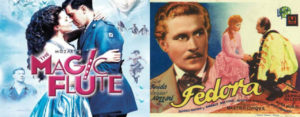
Watch This Before the Metropolitan Opera’s ‘Fedora’ & ‘The Magic Flute’
By Francisco SalazarThis month the Metropolitan Opera celebrates the holiday season with three productions opening.
So we will continue our series that introduces newcomers to opera through film. Opera can be daunting and while some works are more well-known than others, those that have never been to the opera, don’t have the same connection to certain works as traditional operagoers do.
This month audiences will experience, Verdi’s “Aida,” “Giordano’s “Fedora” with Superstar Sonya Yoncheva, and Julie Taymor’s holiday special “The Magic Flute.” Two of these works are staples of the repertoire while one is rarer and is a vehicle for a great diva.
While all three operas have silver-screen adaptations, we will only focus on two of the works being presented this week. More interestingly, the films we will talk about contain many musical moments that will not only prepare you for what you will hear but will also put them into context.
The Magic Flute
Mozart’s opera has influenced many adaptations over the years. There was even a new version this year that starred Oscar winner F. Murray Abraham, Rolando Villazón, and Sabine Devieilhe, among others.
But for this article, we will focus on one adaptation that is friendly for the holidays. Later this season we will look at another version when the opera gets a new production in its original German. For this article, we will focus on the 2006 Kenneth Branagh adaptation sung in English.
The film was made as part of the 250th anniversary celebration of Mozart’s birthday and was set during World War I. The new version featured a translation by Stephen Fry and premiered at the Toronto International Film Festival and Venice Film Festival.
The film was performed by the Chamber Orchestra of Europe conducted by James Conlon and became the first motion picture version of the opera specifically intended for cinemas. Shot in Super 35 and released in anamorphic widescreen, the film starred Joseph Kaiser, Benjamin Jay Davis, Amy Carson, René Pape, Lyubov Petrova, Tom Randle, and Silvia Moi.
Fedora
Fedora’s play has been adapted many times in the early years of cinema and brought numerous silent productions as well as black and white talkies. In 1942, Italian director Camillo Mastrocinque directed a version of the play.
While the film was a minor success it did star Luisa Ferida in the title role, Amedeo Nazzari, and Osvaldo Valenti. The film’s sets were designed by the famed art director Ottavio Scotti and it was shot at the Cinecittà Studios in Rome.
Like many adaptations of its time like “Rigoletto” “Camille,” and “Tosca,” Mastrocinque uses Umberto Giordano’s score to enhance the filmic experience.
You can watch the adaptation here:


